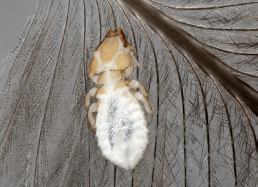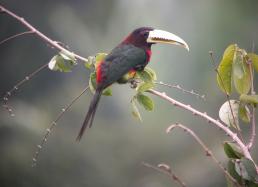Birds & Parasites
In addition to cataloging and sampling bird populations in the Brazilian Amazon, the team's mission also included surveying and studying the parasites found on these birds. Why parasites? First, not only can they tell us a lot about the well-being and behavior of bird communities, but they can also be used to measure an ecosystem's health. Fluctuations in the numbers of parasites within a population can potentially help conservationists pinpoint the impact of habitat disturbance and loss.
Bird parasites can affect human health, too, as we've seen from recent outbreaks of Avian Flu, West Nile Virus, and other bird-related diseases. Studies have shown that environmental changes can influence the distribution and abundance of wildlife species, which in turn impacts parasite-host relationships by altering how diseases are transmitted. New diseases can emerge and eventually be passed along to domesticated animals—and us.
Parasites as Evolutionary Indicators
Beyond their role in disease transmission, there's another reason Amazonian bird parasites are being sampled: they can tell us a lot about bird evolution. For example, by tracking when changes occurred in parasite populations, we can predict more precisely when bird populations stopped exchanging parasites, and probably their own genes, too.
How does this work? When rivers or other ecological events separate bird populations, it takes many generations before this isolation is reflected in the birds' genes. However, because parasites have much shorter lifespans and produce many generations within a brief period of time, their genes record recent history more quickly. So if the parasites found on two bird populations have already evolved to be different genetically, while the birds themselves remain genetically identical, then we know that the two birds populations have been physically separated for only a short time but will continue to evolve on different evolutionary pathways in the future.
Parasite Diversity
Perhaps the most important reason to sample parasites is that they make up approximately 30-70% of Earth's known biodiversity—and yet only a fraction has been described. Considering the exceptionally high numbers of bird species in Amazonia, it's likely that their parasites are equally diverse. Surveying this undocumented diversity before it's severely altered or lost through habitat destruction is critical, given current conservation conditions in Amazonia.
During the 2007 expedition, the team not only sampled 866 birds representing more than 200 species, but they collected more than 430 vials of bird parasites, many of which are new to science. These specimens will remain in the permanent collections of The Field Museum, the Goeldi Museum, and the University of São Paulo Museum of Zoology (which houses one of the largest collections of ectoparasites in South America) to act as a record of the diversity found within the Rio Japurá—a little-explored region that is not well represented by specimens in any collections. In turn, these collections can be used to identify new Areas of Endemism that should be targeted for protection.



